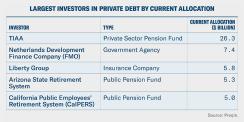The pool of private debt investors continue to expand, even as sector-wide fundraising cools off.
Alternatives data firm Preqin estimated in a report Tuesday that the number of market participants actively investing in private debt grew to 3,200 during the first three months of the year, up from around 3,100 at the end of 2017. Ten institutional investors account for almost 30 percent of all capital invested in the asset class, with TIAA at the top of the list, Preqin said.
The increased interest comes despite just 19 private debt funds closing in the first three months of 2018, the smallest number in at least four years, at least, according to the report. The new funds attracted a combined $14 billion – far below the $25 billion brought in during the same period in 2017, and the lowest amount raised since the third quarter of 2016.
“We are seeing an increasing number of investors turn to private debt, driven in part by the great success the asset class has seen in recent years,” Tom Carr, Preqin’s head of private debt products, said in the firm's statement on the report. Over the five years ending in June 2017, private debt funds recorded double-digit annualized returns, led by direct lending strategies, which returned 13.8 percent.
[II Deep Dive: Private Debt Fundraising May Have Peaked in 2017]
Additionally, close to half of the private debt investors surveyed by Preqin believed public markets were due for correction – a belief that could spur further investment in opportunistic strategies like distressed debt and special situation credit, which could capitalize on a downturn. Distressed debt was the most popular strategy during the first three months of the year, targeted by 52 percent of private debt investors, according to Preqin.
Still, new entrants may have a hard time breaking into private debt, which, as Carr explained, is “dominated by a small group of the most influential institutions.”
According to Preqin, the ten largest private debt investors have committed a combined $71 billion to the asset class. These investors include the Arizona State Retirement System and the California Public Employees’ Retirement System, with allocations of at least $5 billion apiece.
But the largest investor by far is TIAA, a provider of private-sector retirement funds. According to Preqin, the financial services firm had $26.3 billion committed to private debt as of the beginning of this year.
Although 2018 is off to a slow start, Preqin expects private debt fundraising to pick up by year’s end, given the 416 funds currently in market – 66 more than there were at this time last year. The largest fund currently seeking capital, a mezzanine debt fund from Goldman Sachs Group’s merchant banking division, is aiming to raise $10 billion.
In its quarterly earnings report, released on Tuesday, the Carlyle Group said its global credit funds had raised $800 million so far this year, bringing the firm's total credit assets under management to $33.8 billion, up 15 percent from the first quarter last year.








